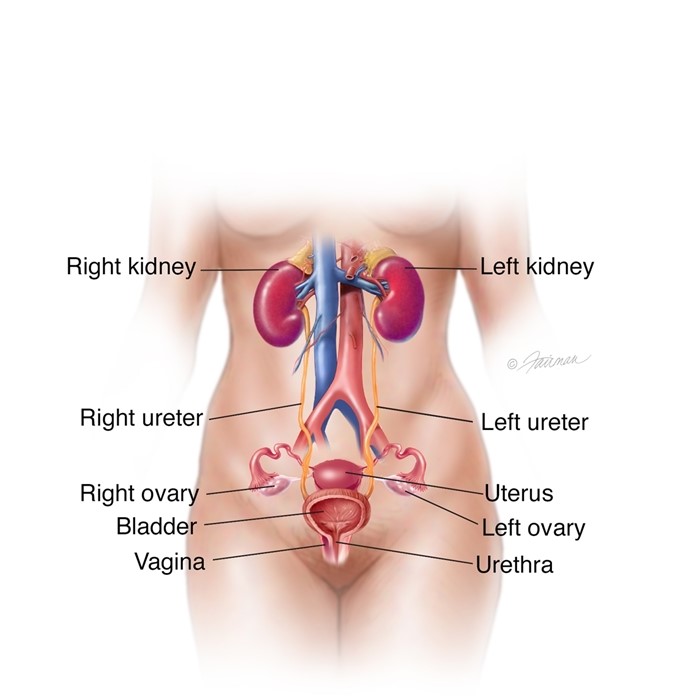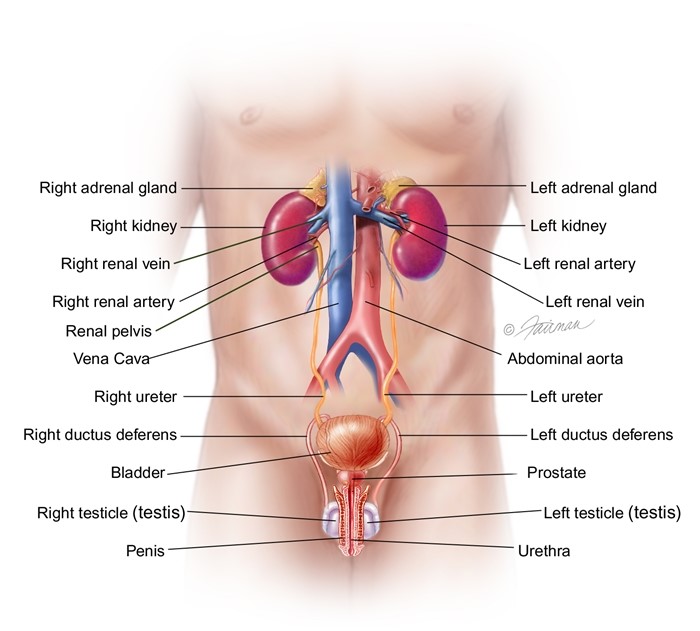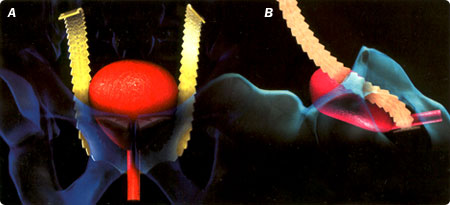Urinary incontinence is an inability to hold your urine until you get to a toilet. More than 13 million people in the United States–male and female, young and old–experience incontinence.
Menu

Urinary Incontinence
Millions of people are affected by the condition of urinary incontinence, with the prevalence increasing by age. About 19 million women and 7 million American men will experience this condition at some point in their lives.
Even though women experience incontinence more frequently than men, once the age of 80 has been reached, both sexes are equally affected. Women typically have urge or stress incontinence caused by an overactive bladder, or a combination of the conditions. With men, prostate conditions are most commonly the culprit.
It may surprise you to learn that urinary continence is not something that normally occurs with aging. Instead, it is a medical condition affecting quality of life. Individuals suffering from urinary incontinence have higher rates of depression, dependence on caregivers, and restricted social and sexual function.
What is urinary incontinence?
Urinary incontinence is a medical condition involving uncontrolled urine leakage. Although many men and women experience this condition, we are not exactly sure how many have this condition. It is believed that many individuals do not reveal their symptoms due to embarrassment, or simply feeling that nothing can be done since they mistakenly believe urinary incontinence is an inevitable consequence of aging. So they tend to suffer needlessly in silence.
Urinary Incontinence Statistics
Roughly 33 million Americans have an overactive bladder that leads to feelings of urgency or frequency that may or may not occur in conjunction with urge incontinence.
Research has revealed that a number of factors increase the risk of developing urinary incontinence. Factors like aging and pregnancy raise the risk of developing urinary incontinence among women. Having many children also increases the risk, which is true for both vaginal delivery and C-section.
Pregnant women who develop urinary incontinence are more likely to have it recur later on. Women who have undergone menopause may also develop urinary incontinence, which often occurs due to a decrease in estrogen levels. However, taking supplemental estrogen has not been found to assist in relieving urinary incontinence.
Men with prostate problems have an increased risk of developing urinary incontinence. Some medications may be associated with urinary incontinence or make the condition worse. Poor overall health also has been found to increase the risk of developing urinary incontinence. Associations have also been found between conditions like stroke, diabetes, and high blood pressure that are linked to urinary incontinence.
Another known risk factor for urinary incontinence is obesity. If you are overweight, you can lessen urinary incontinence symptoms and improve your bladder function by losing weight.
Normal Urinary Function
Proper urinary function is under the control of both the brain and bladder. The bladder is responsible for storing urine until you are ready to eliminate it from your body. Lower pelvis muscles hold your bladder in place. The smooth muscles of your bladder are normally relaxed so that urine is held within your bladder. The end of your bladder should be closed. Around the urethra, sphincter muscles should be closed. If your sphincter muscles are keeping your urethra closed, urine should not leak.
When you are ready to begin urinating, your brain will send the bladder a signal, causing its muscles to contract. Urine is then forced out through your urethra, which is the tube carrying urine from your body. When the bladder contracts, the sphincter opens up.
Types of Urinary Incontinence
There are three categories of urinary incontinence, and you could actually experience multiple types simultaneously.
Stress Incontinence
Certain kinds of physical activities can trigger stress incontinence. You may lose bladder control when you:
- Exercise
- Cough
- Sneeze
- Laugh
These types of physical exertions can place stress upon sphincter muscles retaining urine within your bladder. This additional stress can lead to the release of urine by affecting the muscles in the area.
This type of incontinence tends to occur due to weakened pelvic muscles and occurs more frequently among older women. The stretching of pelvic floor muscles is also involved.
Although the FDA has not approved medications for the treatment of stress incontinence, you can help to manage it by strengthening your pelvic floor using Kegel exercises. Other ways of managing the condition include the use of vaginal and urethral devices, certain lifestyle changes, and even surgery.
Urgency Incontinence
Urge incontinence is a type of urinary incontinence occurring whenever you lose control of your bladder after you have experienced a strong and sudden urge for urination. When that sudden urge arises, you may not reach the bathroom in time.
Over 30% of men are affected by urgency incontinence, while 40% of American women are affected. This condition may restrict your activities, and you may fear being away from a bathroom when you suddenly need to urinate. It may even affect the quality of your sleep.
With this condition, your brain is telling your bladder to empty itself, although it may not even be full. Or you may have hyperactive bladder muscles that squeeze before your bladder is completely full, giving you the feeling that you need to urinate.
Overflow Incontinence
This type of incontinence may develop if you are not able to fully empty your bladder when urinating. You may find that remaining urine dribbles out later on.
Overflow incontinence may be due to a blockage of the urine flow or improper bladder muscle contractions. You may frequently urinate only a small amount of urine or experience dribbling, which is a constant drip of urine.
Women rarely experience this form of urinary incontinence. Instead, men more commonly experience it when they have had prostate surgery or ongoing prostate problems.
Let’s take a look at some common causes of urinary incontinence.
The Aging Process
As you grow older, your bladder muscles tend to weaken, increasing your risk of developing urinary incontinence. So that you maintain a healthy bladder and strong muscles, you need to be practicing healthy lifestyle choices. The greater your health, the higher your odds of avoiding urinary incontinence as you grow older.
Damage
Your bladder is supported by pelvic floor muscles that can become damaged, leading to urinary incontinence. Some types of surgery, like a hysterectomy procedure, can also affect the pelvic floor muscles. Childbirth and pregnancy are common causes of damage to the area.
Enlarged Prostate
If you are male, you have a prostate gland surrounding the end of your bladder. You prostate releases fluid that nourishes and protects your sperm cells. Prostates typically enlarge as you grow older, which can lead to some experience of incontinence.
Cancer
If you develop bladder or prostate cancer, this can lead to urinary incontinence. Some types of cancer treatments can also make it more difficult in controlling your bladder function. Certain types of benign tumors can also block the flow of your urine, leading to incontinence.
When should I seek medical help?
Any type of urinary incontinence is a good reason to contact your medical team. It needs to be checked out because it could indicate a more significant condition requiring treatment. Although the underlying cause may not be severe, urinary incontinence can seriously impact your quality of life, so it is important to receive a proper diagnosis so that you can go over your treatment options during a consultation with Dr. Antun.
Sometimes, urinary incontinence may represent a medical emergency.
Seek emergency medical care if you lose bladder control and should experience any of these symptoms:
- Difficulty walking or speaking
- Tingling or weakness in any part of your body
- Vision loss
- Confusion or loss of consciousness
- Losing bowel control
What type of treatment can I receive for urinary incontinence?
Dr. Antun can develop an individual treatment plan for you based upon the cause of your urinary incontinence. If you have an underlying medical condition that is related to your incontinence, he may prescribe medication, or recommend surgery or other types of treatments.
You may also receive a recommendation to perform some types of exercises like bladder training or pelvic floor exercises to improve your bladder control.
Prevention of Urinary Incontinence
Although you cannot always prevent every case of urinary incontinence, there are certain helpful steps that can help lower your odds of developing this common condition. A healthy lifestyle is very important, and you should try to:
- Maintain a healthy weight
- Get regular exercise
- Eat a balanced and healthy diet
- Do not smoke
- Limit your consumption of alcohol and caffeine
The Bottom Line
Although urinary incontinence can seriously impact your quality of life, Dr. Antun stands ready to assist you in alleviating your symptoms through a proper diagnosis and development of an individualized treatment plan.
Do not be bashful or hesitant to contact our office if if you should experience any symptoms of urinary incontinence, a very common medical problem that Dr. Antun is trained to diagnose and treat.

Female Urinary Tract

Male Urinary Tract

Small intestinal submucosa suburethal sling placement: (A) front view and (B) side view
NEED ASSISTANCE?
Contact Us
- (305) 548-4005
- info@urologycure.com
- 7600 SW 57th Ave STE 213, South Miami, FL, United States, 33143
Reach us now!
Sign up to get the latest news and deals on Urology treatments!
get social:
Urology Cure ©2019 All rights Reserved.
